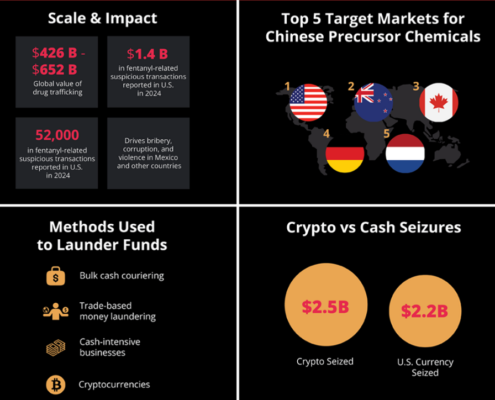
AML/CFT and Sanctions Enforcement Actions in 2025
2025 will go down as a historic year for AML/CFT and sanctions-related enforcement actions in two ways. It’s the first time in over 20 years that no banks have faced major penalties, and state regulators began jointly penalizing institutions.

Debt & Duty
Chinese Money Laundering Networks target students to operate as money mules to launder cartel proceeds. Learn more about the methods used for recruitment and control, and the red flags that financial institutions can use to identify and respond.

Navigating the Convergence of Sanctions Evasion, Export Control Evasion, and Money Laundering
Explore the convergence of illicit finance domains through real-life examples including Russia’s procurement of drone components, Iran’s evasion networks, and China’s acquisition of restricted chips.

Laundering Luxury
‘Daigou’ buyers purchasing luxury items in the U.S. for sale in China are often funded by Chinese Money Laundering Networks using financial proceeds of cartel activities. Learn how these methods operate, the red flags financial institutions can identify, and the actions to take in response.

Terrorist Drug Trafficking Organizations
This article provides background on designated cartels — their geographic reach, how they raise and move money, the risks they pose to financial institutions, and common red flags that may help financial institutions to identify suspicious activity.

FATF’s Recent Risk Map Update
FATF’s June 2025 update—new grey list additions and unchanged high-risk jurisdictions mean updated risk scores, stronger due diligence, and sharper monitoring for compliance teams. Here are three actions to take now.

Out of the Shadows
Iran’s shadow banking system has laundered billions of dollars for the regime. In this article, we detail how the system works and how financial institutions can identify red flags associated with Iran’s oil smuggling and concealed payment networks.

Cartels & Crypto
Cartels and the professional money launderers that service them have integrated digital assets throughout the narcotics trade, from precursors to sales and laundering proceeds.

Canada’s Strong Borders Act
Canada’s Strong Borders Act represents a sweeping overhaul of the country’s AML/CFT regime. The legislation introduces tougher penalties, expanded oversight, and stricter compliance and enforcement expectations.

A Dangerous Alliance
Today, on United Nations International Day Against Drug Abuse and Illicit Trafficking, we spotlight a dangerous financial alliance accelerating the fentanyl crisis: transnational partnerships between Mexican cartels and Chinese money laundering networks.
